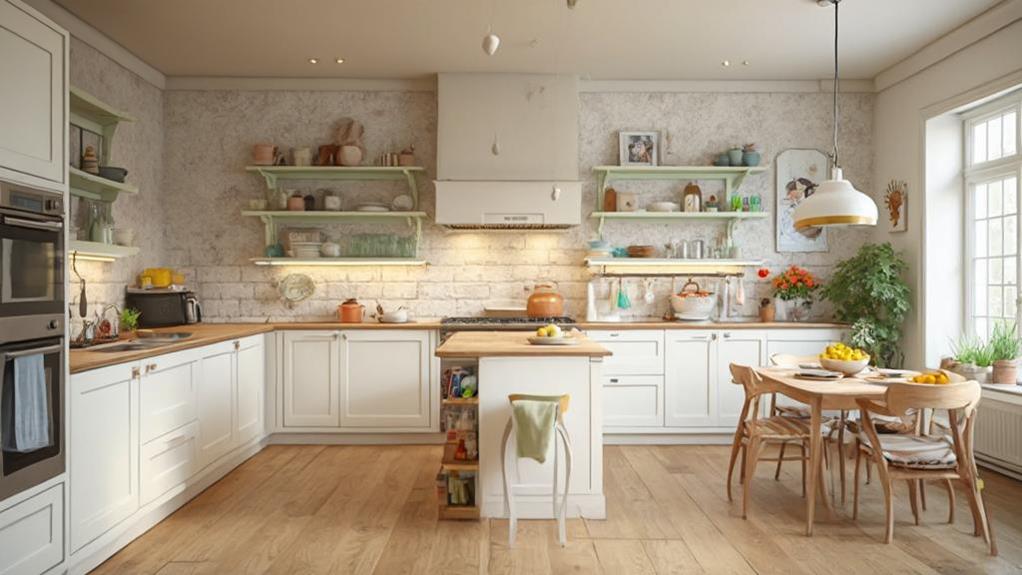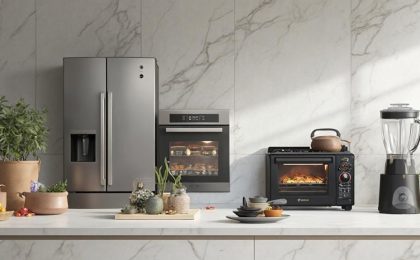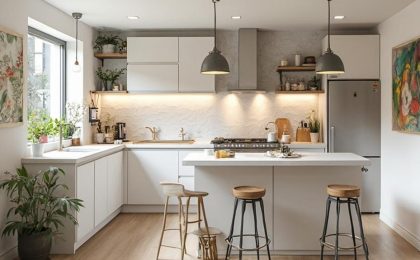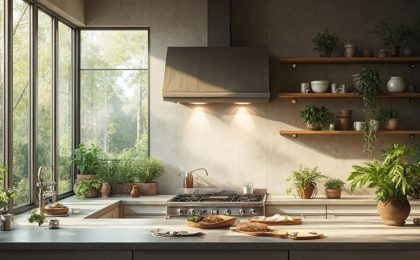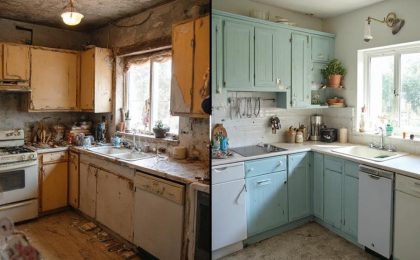When you're designing a family-friendly kitchen, it's essential to strike a balance between safety and functionality. You want a space that not only accommodates cooking but also fosters family interaction without compromising on safety. By incorporating features like childproof cabinets and slip-resistant flooring, you can reduce risks while ensuring the kitchen remains a hub for family activities. But what other elements should you consider to enhance both safety and usability in your kitchen? Let's explore some practical tips that can make a significant difference.
Key insights
- Incorporate safety features like childproof cabinets, rounded countertop edges, and slip-resistant flooring to prevent accidents in the kitchen.
- Design a functional layout by defining cooking, prep, and cleanup zones, ensuring easy access to frequently used appliances.
- Select durable, non-toxic materials like quartz and ceramic for countertops and flooring, ensuring safety and easy maintenance.
- Maximize lighting with a combination of natural light, task, and ambient lighting to enhance safety and create a welcoming atmosphere.
- Engage family members in the design process to reflect collective needs, fostering involvement and enhancing family bonding in the kitchen.
Prioritize Safety Features
When designing a family-friendly kitchen, safety features should be at the forefront of your planning. You'll want to create an environment that encourages family meals without compromising on safety.
Start with kitchen appliances; choose models with safety locks and automatic shut-off features. These not only prevent accidents but also give you peace of mind, especially when kids are around. Additionally, consider consulting with local bathroom fitters who can provide insights on integrating safety into your kitchen design.
Consider the placement of these appliances, too. Keeping them out of reach or installing them at lower heights can help prevent curious hands from accessing hot surfaces or sharp tools.
Opt for rounded countertop edges to minimize injury risks, and make sure that heavy items are stored in lower cabinets to avoid accidents from falls.
Don't overlook your flooring; slip-resistant materials are vital for a space where spills are common. Bright lighting is another significant element, illuminating potential hazards and making certain everyone can see what they're doing while preparing family meals.
Optimize Layout for Flow
To create a truly functional and inviting family-friendly kitchen, optimizing the layout for flow is essential. Start by defining your kitchen zones, such as cooking, prep, and cleanup areas. Each zone should be strategically placed to enhance workflow efficiency and minimize unnecessary movement.
Think about traffic patterns—ensure that pathways are wide and unobstructed, allowing family members to navigate easily, especially when they're involved in cooking or entertaining. Additionally, hiring local kitchen fitters can provide tailored solutions that reflect your family's needs and preferences.
Consider appliance placement carefully. Position frequently used appliances, like the refrigerator and stove, within easy reach of each other. This setup not only saves time but also encourages family involvement in meal preparation.
Incorporating open spaces allows for multifunctional areas where family members can gather, socialize, or help with cooking tasks. Designate gathering spots, like an island or a breakfast nook, where everyone can converge. This not only fosters connection but also keeps the kitchen lively and engaging.
Use Childproof Materials
Safety should be a top priority in any family-friendly kitchen, making the choice of materials vital. When designing your kitchen, opt for non-toxic finishes that guarantee your space is safe for little ones. Many paints and coatings contain harmful chemicals, so look for products labeled as low-VOC or zero-VOC.
These finishes not only protect your family's health but also contribute to a cleaner indoor environment. Additionally, choosing surfaces that are easy to clean and maintain, such as those offered by local tile fitters in Bradford, can enhance both safety and aesthetics in your kitchen expert advice on tile selection.
Furthermore, consider heat-resistant materials for surfaces like countertops. Materials such as quartz or ceramic aren't only durable and stylish but can withstand high temperatures without warping or damaging. This is essential when hot pots and pans inevitably make contact with surfaces in a bustling kitchen.
Investing in soft-close cabinet doors and drawers can prevent pinched fingers, adding another layer of safety. By prioritizing non-toxic finishes and heat-resistant materials, you create a kitchen that's not only functional but also a nurturing space for your family.
Ultimately, these choices reflect a commitment to both safety and style, allowing everyone to feel comfortable and secure in the heart of your home.
Incorporate Secure Storage
When designing a family-friendly kitchen, incorporating secure storage is crucial for safety and functionality.
You can opt for childproof cabinets to keep harmful items out of reach, while organizing high shelves guarantees that your kitchen remains clutter-free and accessible.
This thoughtful arrangement not only protects your little ones but also enhances your cooking experience.
Use Childproof Cabinets
Childproof cabinets are essential for creating a safe kitchen environment, especially in homes with young children. By incorporating childproof locks into your cabinet design, you can greatly reduce the risk of accidents. These locks are specifically engineered to keep curious little hands away from hazardous items like cleaning supplies, sharp utensils, and medications.
When selecting childproof locks, consider options that are easy for adults to operate but pose a challenge for kids. Magnetic locks are popular because they require a special key to open, while sliding locks offer a simple solution for cabinets that hinge outward.
Integrating these features into your cabinet design not only enhances safety but also maintains the kitchen's aesthetic appeal. Additionally, verify that your cabinets are installed securely and that the hardware is durable. This will prevent any accidental openings, even if your child tries to climb or pull on the doors.
Organize High Shelves
To create a functional kitchen space, organizing high shelves is essential, especially for families with children. When you thoughtfully arrange these elevated areas, you maximize space while keeping potentially dangerous items out of reach.
Start by evaluating what you store on these shelves. Use sturdy shelving systems that allow for easy access and visibility.
Consider what you want to place high up—items like baking supplies or seasonal dishware. These should be securely stored, ensuring they're not easily toppled.
For everyday items, look into step stool solutions. A reliable step stool not only gives you access to those high shelves but also encourages safe retrieval, making it easier to reach what you need without stretching or climbing unsafely.
Utilize baskets or bins that can slide easily on the shelves, allowing you to pull out items without overreaching. Label these containers for added convenience.
Design Durable Surfaces
In a bustling family kitchen, selecting durable surfaces is essential for both functionality and longevity. You'll want to choose materials that can withstand daily wear and tear while still providing aesthetic appeal.
Opting for durable materials not only saves you money in the long run but also keeps your kitchen looking fresh.
Consider these options for durable surfaces:
- Quartz countertops: They offer a non-porous surface that resists stains and scratches while requiring minimal maintenance.
- Ceramic tiles: Perfect for backsplashes and flooring, they're tough and easy to clean, making them ideal for family environments.
- Stainless steel: This material isn't just sleek; it's resistant to heat and bacteria, providing both durability and sanitation.
When selecting surface finishes, prioritize those that are easy to maintain. Regular cleaning and avoiding harsh chemicals can prolong their lifespan.
Remember, a family-friendly kitchen is one that balances durability with style, ensuring you can create memories without worrying about damaging your surfaces.
Ensure Adequate Lighting
Proper lighting can transform a kitchen into a safe and inviting space, enhancing both its functionality and atmosphere. To achieve this, consider a mix of ambient and task lighting. Ambient lighting sets the overall mood, while task lighting directs attention to critical areas like countertops and stoves.
Use natural light whenever possible; large windows or skylights can brighten your kitchen during the day, reducing reliance on artificial sources.
When selecting lighting, pay attention to color temperature. Warmer tones create a cozy vibe, while cooler tones can enhance focus. Adjustable fixtures, such as pendant lights or under-cabinet lighting, allow you to tailor illumination according to your needs. Dimmable options offer flexibility, enabling you to adjust brightness for different tasks or times of day.
Light placement is key; guarantee that fixtures illuminate workspaces effectively, minimizing shadows that can lead to accidents. Incorporating energy-efficient bulbs not only reduces your energy consumption but also lowers your utility bills.
Create a Learning Zone
A dedicated learning zone in your kitchen can serve as a dynamic space where family members gather to explore cooking skills, engage in homework, or enjoy crafting activities. By creating this area, you foster interactive learning that enhances kitchen activities while keeping everyone involved in the heart of your home.
To design an effective learning zone, consider these elements:
- Accessible Counter Space: Guarantee there's a countertop or table where kids can safely participate in cooking or homework.
- Organized Supplies: Stock the area with essential tools like measuring cups, utensils, and art supplies, so everything's within reach for spontaneous activities.
- Comfortable Seating: Choose stools or chairs that are easy to move and comfortable, encouraging longer engagement during learning sessions.
This space not only encourages family bonding but also teaches valuable skills in a fun and practical way.
By integrating learning with everyday kitchen activities, you help your family appreciate the joy of cooking and creativity, making your kitchen a vibrant hub of knowledge and interaction.
Involve the Family in Design
Engaging the entire family in the design process of your kitchen not only strengthens bonds but also guarantees the space reflects everyone's needs and preferences.
Start by gathering input from each family member. Discuss what they enjoy about cooking and what they'd like to see improved. This design collaboration can reveal valuable insights into family preferences, ensuring your kitchen becomes a space everyone can appreciate.
Consider organizing a brainstorming session where everyone can express their ideas, whether it's a specific layout, color scheme, or desired appliances.
Sketching out concepts together can foster creativity and give each member a sense of ownership in the project.
You can also involve the family by visiting design stores or browsing online for inspiration.
This hands-on approach not only educates everyone about the design process but also helps in making collective decisions.
Frequently Asked Questions
What Age Should Children Start Helping in the Kitchen?
Determining the appropriate age for children to start helping in the kitchen varies, but you can generally involve them around age 3.
At this age, they can assist with simple tasks like washing vegetables or stirring ingredients.
As they grow, you can assign more complex kitchen roles, such as measuring ingredients or setting the table.
This not only teaches them valuable skills but also fosters a sense of responsibility and teamwork in the kitchen.
How Can I Teach Kids Kitchen Safety Effectively?
To teach kids kitchen safety effectively, start by identifying common kitchen hazards, like hot surfaces and sharp utensils.
Create clear safety rules, such as always using oven mitts and keeping knives out of reach when not in use.
Engage them in fun, hands-on activities that reinforce these rules.
Role-playing scenarios can help them understand consequences.
Are There Kid-Friendly Kitchen Gadgets Available?
Absolutely, there are plenty of kid-friendly kitchen gadgets available.
You'll find kid-friendly utensils like colorful measuring cups and easy-grip knives designed for small hands.
Interactive cooking tools, such as silicone molds and spatulas with fun shapes, make cooking fun and engaging.
These gadgets not only encourage creativity but also help kids develop essential cooking skills safely.
When you involve them in the kitchen, you're fostering their independence and love for cooking!
How Often Should I Childproof My Kitchen as Kids Grow?
You should regularly assess your kitchen for hazards as your kids grow.
Childproofing strategies aren't one-time fixes; they need to evolve with your child's abilities and curiosity.
Start by identifying kitchen hazards, like sharp utensils or hot surfaces.
As your child becomes more mobile or independent, reevaluate your safety measures every six months.
This proactive approach guarantees a safer environment, allowing your kids to explore while minimizing risks associated with everyday kitchen activities.
What Are Some Easy Recipes for Kids to Try?
When you think about fun cooking with kids, consider simple recipes that spark their interest while promoting healthy snacks.
Try making fruit kabobs with colorful fruits or yogurt parfaits layered with granola. Mini pizzas using whole-grain tortillas allow them to customize their toppings, fostering creativity.
You can also experiment with smoothies, blending their favorite fruits and veggies.
These recipes not only engage kids but also instill healthy eating habits early on.
Summary
In designing a family-friendly kitchen, you're not just creating a space; you're fostering an environment where safety and functionality thrive. By prioritizing safety features, optimizing the layout, and using durable materials, you set the stage for memorable family moments. Incorporating secure storage and adequate lighting further enhances the experience. Involving your family in the design process guarantees that everyone feels valued and invested. Ultimately, your kitchen becomes a hub for creativity, learning, and togetherness.
